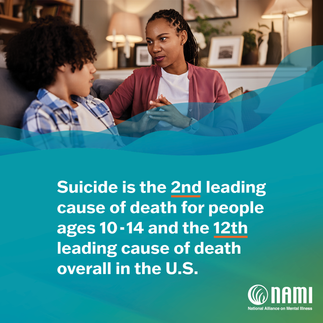September is Suicide Prevention Month — a time to raise awareness of this urgently important crisis.
- creativewendy9
- Sep 2, 2024
- 4 min read

If you or someone you know is struggling or in crisis, help is available. Call or text 988 or chat 988lifeline.org to reach the 988 Suicide & Crisis Lifeline.
Suicidal thoughts, much like mental health conditions, can affect anyone regardless of age, gender or background. Suicidal thoughts, although common, should not be considered normal and often indicate more serious issues.
September is Suicide Prevention Month — a time to raise awareness of this urgently important crisis. We use this month to shift public perception, spread hope and share vital information to people affected by suicide. Our goal is ensuring that individuals, friends and families have access to the resources they need to discuss suicide prevention and to seek help.
Crisis Resources
If you or someone you know is experiencing a mental health crisis, call or text 988 immediately.
You can also chat with the Suicide & Crisis Lifeline at 988lifeline.org.
Need more information, referrals or support? Contact the NAMI HelpLine.
STATISTICS
Individual Impact:
79% of all people who die by suicide are male.
Although more women than men attempt suicide, men are 4x more likely to die by suicide.
Suicide is the 2nd leading cause of death among people aged 10-14, the 3rd leading cause of death among those aged 15-24 and the 12th leading cause of death overall in the U.S.
46% of people who die by suicide had a diagnosed mental health condition — but research suggests that 90% may have experienced symptoms of a mental health condition.
Community Impact:
Annual prevalence of serious thoughts of suicide, by U.S. demographic group:
U.S. Adults: 4.8%
Native Hawaiian/other Pacific Islander: 7.4%
Mixed/Multiracial: 8.2%
American Indian/Alaska Native: 8.5%
Young adults aged 18-25: 13%
High school students: 22%
LGBTQ youth: 41%
The highest rates of suicide in the U.S. are among American Indian/Alaskan Natives, followed bynon-Hispanic white people.
Lesbian, gay and bisexual youth are 4x more likely to attempt suicide than straight youth.
Transgender adults are nearly 9x more likely to attempt suicide at some point in their life compared to their peers.
Suicide is the leading cause of death for people held in local jails.
Data from CDC, NIMH and other select sources.
KNOW THE WARNING SIGNS
ADDITIONAL RESOURCES
Read the NAMI Blog and Share
The NAMI Blog features content related to our awareness events. Be sure to visit the NAMI Blog at nami.org/Blog and look for posts on our social media channels featuring quotes from our authors.
Relevant Blogs About Suicide Prevention
How to Talk to Your Teen About Suicide Filmmaker and Youth Mental Health Advocate Jason Reid shares what he’s learned about suicide prevention and teens’ mental well-being after losing his son, Ryan, to suicide.
How to Ask Someone About Suicide After losing her brother to suicide, Sally made a commitment to learn more about suicide — especially how to talk openly about it. Here, she shares her best practices for having difficult conversations.
Reclaiming the Memories of My Sister Psychology professor Eleni Pinnow opens up about losing her sister to suicide and the complex journey to find comfort in the happy memories of her sister.
How to Help Yourself and Others with Suicidal Ideation Ginger Robertson talks about what suicidal ideation feels like and what you can do to help yourself or others going through it.
How to Talk (and Listen) to Someone Experiencing Suicidal Thoughts Vice President of the Hecht Trauma Institute Kevin Connors provides a blueprint for starting the conversation about suicide with loved ones at risk.
How Mindfulness Helped Me Cope with My Husband’s Suicide Lenore Matthew shares how an unexpected technique became a coping mechanism as she grieved the loss of her husband.
Get Inspired by NAMI.org Personal Stories
We will also feature personal stories of lived experience on our website at www.nami.org and on our social media channels. Personal stories are brief, informal pieces submitted to NAMI. By sharing these stories, we aim to highlight the importance of mental health in all communities and to make people feel less alone in their mental health journeys.
Videos
NAMI's website features videos from people sharing their stories of lived experience, such as NAMI Support Groups: A Safe Space, a video about the powerful and positive impact that NAMI support groups have on their lives and Surviving Loss: A Father’s Journey about NAMI Michigan’s executive director, Kevin Fischer, and his journey of finding NAMI and his purpose — to take on stigma and address men’s mental health. Look for additional content to be uploaded to our YouTube channel throughout the month.
Other Resources Around Suicide Prevention
To address the mental health crisis in the Black/African Ancestry community, NAMI’s Community Health Equity Alliance (CHEA) created the Crisis Can't Wait Campaign: a campaign designed to help reduce mental health crises in Black/African Ancestry communities around the country. Join us in sharing resources with changemakers in your community who are ready to make a difference. Together, we can stop these crises and connect people with the care and support they need, because Crisis Can’t Wait.
988 FAQs available at nami.org/988
WHAT YOU CAN DO
Advocate
Join our movement to advocate for a better mental health care system by signing up for advocacy alerts and taking action when opportunities arise in your community.
Your advocacy matters to help people in mental health and suicidal crisis! Visit NAMI’s 988 Crisis Response State Legislation Map to learn more about what’s happening in your state and across the country.
Read and share NAMI’s State Legislative Brief on Trends in State Policy: 988 and Reimagining Crisis Response to learn about innovative ways states are improving suicide prevention and crisis services.
Explore how your community can #ReimagineCrisis. Find advocacy resources and information to build a better mental health and suicide crisis response system for everyone, no matter who they are or where they live.
Join us in recognizing #988Day on September 8. 988 Day is a national initiative dedicated to raising awareness about 988 and emphasizing the importance of mental health and suicide prevention.
Stay up to date on how you can advocate for better suicide prevention and mental health crisis support by signing up for NAMI’s Federal Advocacy Alerts.




































Comments